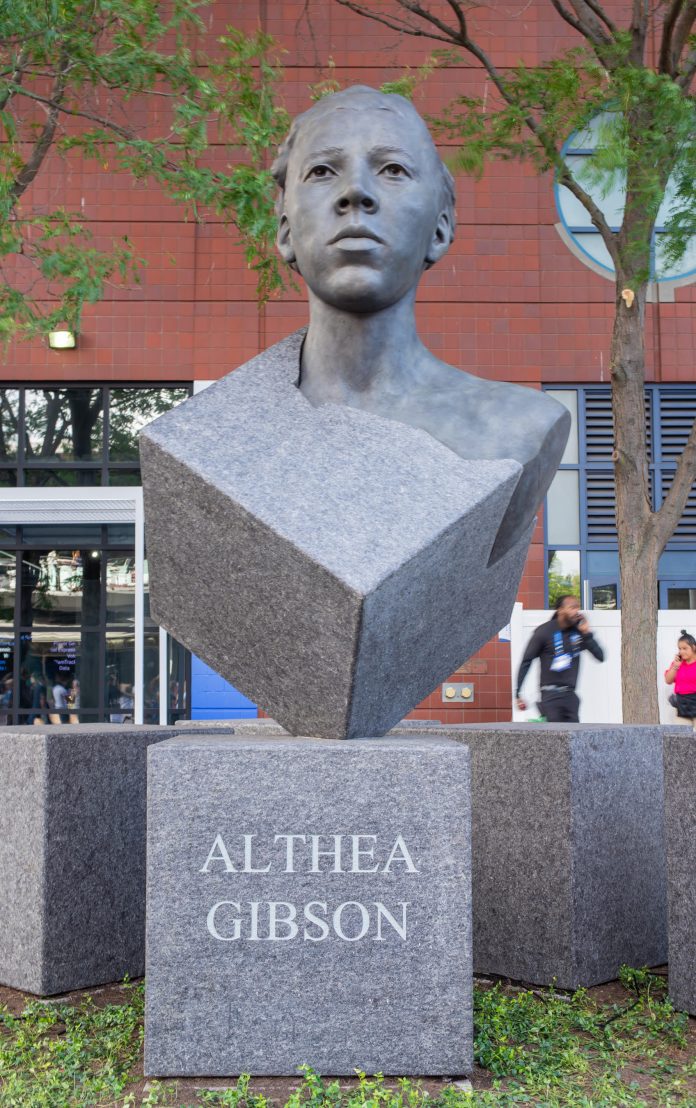Bill Simons
New York
Whitney Houston pleaded:
“Give me one moment in time
When I’m more than I thought I could be
When all of my dreams are a heartbeat away
And the answers are all up to me
Give me one moment in time
When I’m racing with destiny
Then in that one moment of time
I will feel –
I will feel eternity.”
That’s what the songster belted out in 1997 at the opening of Ashe Stadium. It sent shivers through the crowd. I wept. Why not? Here the biggest tennis stadium in the world was being named after a humble man of conscience, a flowing tennis player who battled for one noble cause after another.
After the US Open’s stunning, $262 million stadium was named after Arthur Ashe, there have been so many moments of glory for persons of color. I think of James Blake’s 2005 battle against Andre Agassi, which still might be the best night match in tennis history. It’s hard to forget the 2001 primetime final between Serena and Venus. 60 Minutes’ Ed Bradley noted, “This sport used to be so lily-white, but here you have two African-American women playing for the title in Ashe Stadium, and the stadium next door is Louis Armstrong Stadium. That says it all. Arthur Ashe is smiling.”
On this cool New York morning there were again lots of smiles in town. First, in Manhattan, Ashe was posthumously inducted into the Tennis Industry Association Hall of Fame. Then, just two hours later, a stunning, almost imposing statue of the great pioneer Althea Gibson was at last unveiled. One star after another shared their truths.
Venus Williams noted, “It wasn’t easy to be African American in the ’50s…It was impossible to do that, and she did…I can’t imagine what she went through. Because she went through that. I didn’t have to…Who knows what kind of line calls she got?..I don’t think anyone really understands what it was like.
“My mom and dad do because they grew up in the ’40s, ’50s, [in] Mississippi and Louisiana. This is a country where we came for freedom and it was unfortunate that many people were not given that. And because of Althea [and] people fighting for it, we have gotten a lot closer.”
None other than Billie Jean King recalled, “I was 13 and playing in a 15-and-under at the community center in the Los Angeles Tennis Club when I finally got to see Althea play. It was at that moment, in seeing how extraordinarily talented and athletic she was, that I realized what being No. 1 looked like…I learned if you can see it, you can be it…Without a doubt, she was our Jackie Robinson…She opened the door for all our us, enlightened all of us, and inspired all of us.”
Former WTA star Leslie Allen recalled, “She didn’t complain to me about racism, sexism and being virtually forgotten. She made sure that I understood the significance of her legacy…We were in Africa when Althea said, ‘My job was to bust down, to break down the door so that you and the next generations could walk right on through, so that each one of us could have more.’ Well, look at us now. At this US Open, 18 of the 39 American women players are people of color.”
Wimbledon finalist Zina Garrison recalled that when she was 15, Gibson told her, “Zina, you need to work on your serve…Eventually, I realized she was actually talking about serving others and not just serving myself, and that I need to pass on the wisdom…and especially to African American tennis players.”
In my mind, former USTA President Katrina Adams should have the last word on a statue she so tirelessly pushed for decades. Adams said, “Althea was the first to break the color barrier in tennis, the first African American to have an opportunity to perform on the great stages…the first person of color to win the French Nationals and Wimbledon and the US Nationals back to back. She used her success in early ATA [all African-American] tournaments as a pathway to earning a college scholarship…I met her at the age of nine or ten and…her presence made me feel humbled and inspired…The sport she loved so much didn’t love her back in the way that it…should have. Her accomplishments were in the pre-Open Era, and not enough of our history pre-1968 is revered in the way that it should be – but today, that all changes.”
Ten miles away and a couple of hours earlier, Arthur Ashe’s friend Stan Smith had told a meeting of the Tennis Industry Association, “You really have to be new to tennis to not know that Billie Jean King is a tennis center, that Ashe is a stadium and Stan Smith is a shoe (i.e. the Adidas sneaker that’s the best seller in tennis history).
Smith noted, “When I think of Arthur the words that come to mind are: activist, visionary, encourager, innovator, leader, writer, speaker, creator, team player, husband, father and loyal friend.
“As a player, when I looked over the net, I never knew what was coming. When he got into his flow, you didn’t know what to expect. Your job was to try and interrupt that and get him out of his flow. Hopefully, he wouldn’t keep it up. But if he stayed in the flow, at the end of the match you felt you should pay him for the lesson you got.
“Now, the word that really drove Arthur Ashe was education. He realized that if people wanted to pursue their dreams and reach their potential, they needed education. So he left home to go to UCLA.
“Arthur was constantly reading magazines, papers and books. He was inquisitive and he wanted to improve the world. He started with the tennis. He was one of the founders of the ATP and one of the leaders of our 1973 boycott of Wimbledon to establish players rights. And he sought a code of conduct and was fortunate that he had Ilie Nastase to be the example of why we wanted to have a code of conduct.
“He was a big part in creating the non-wood Head racket…and he wrote the book A Hard Road To Glory about the history of African American athlete.
“He continued preaching education to young people and tried to use sports to get an education. Arthur loved the US…but I think of him as ‘a man of no borders.’ His favorite T-shirt said, ‘Citizen of the world.’”
Today in New York no superstar was on hand to sing an inspirational song. Yet this, too, was undoubtedly “one moment in time.” when two greats were honored. Memory matters.



















